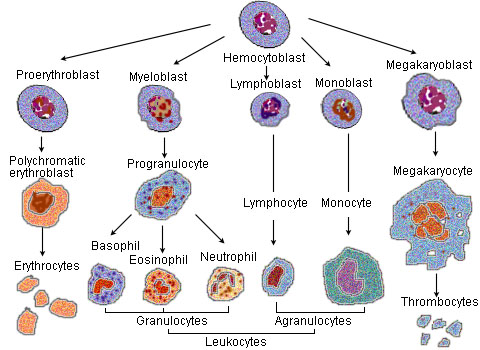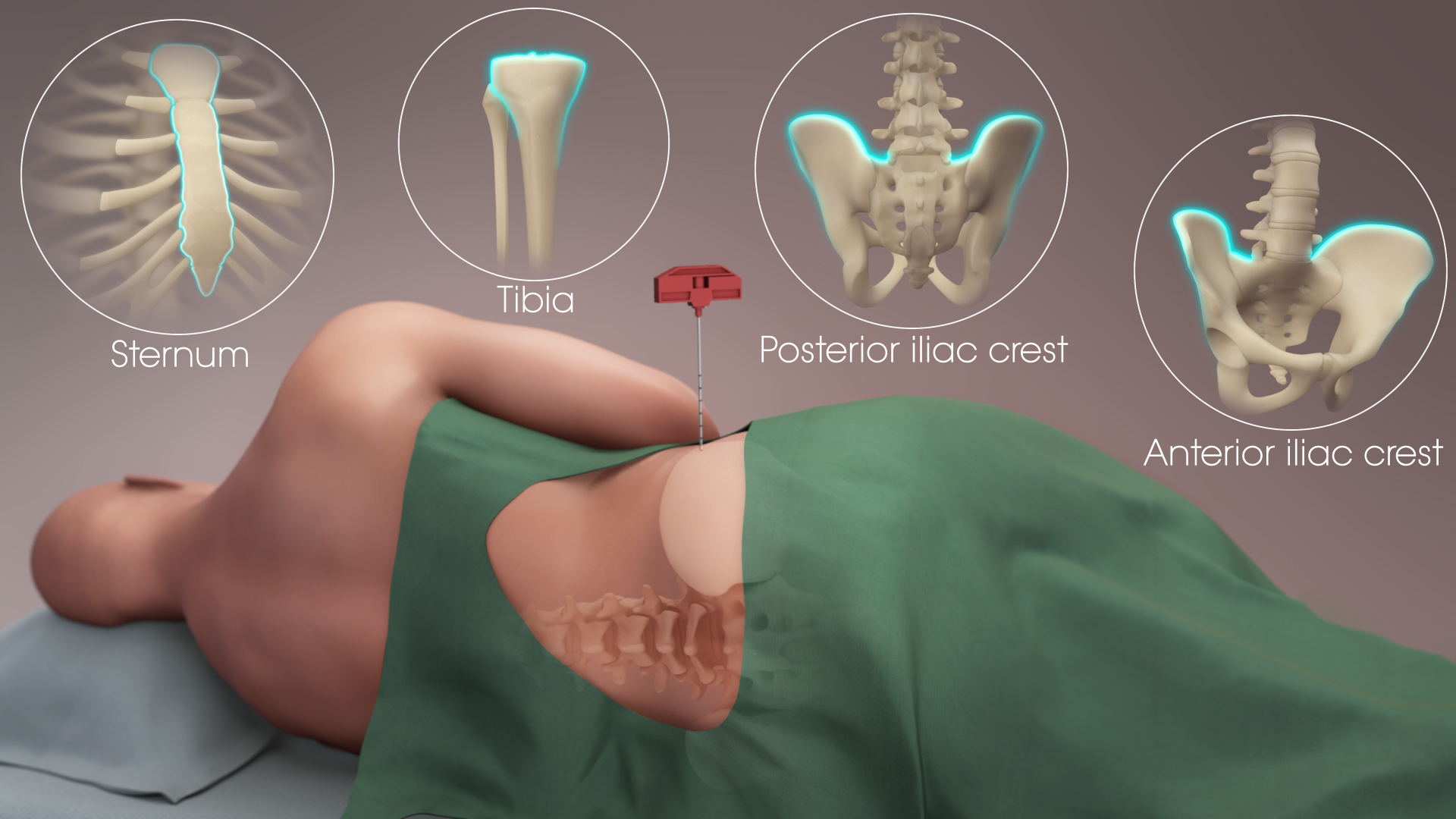|
Megakaryocytes
A megakaryocyte () is a large bone marrow cell with a lobated nucleus that produces blood platelets (thrombocytes), which are necessary for normal clotting. In humans, megakaryocytes usually account for 1 out of 10,000 bone marrow cells, but can increase in number nearly 10-fold during the course of certain diseases. Owing to variations in combining forms and spelling, synonyms include megalokaryocyte and megacaryocyte. Structure In general, megakaryocytes are 10 to 15 times larger than a typical red blood cell, averaging 50–100 μm in diameter. During its maturation, the megakaryocyte grows in size and replicates its DNA without cytokinesis in a process called endomitosis. As a result, the nucleus of the megakaryocyte can become very large and lobulated, which, under a light microscope, can give the false impression that there are several nuclei. In some cases, the nucleus may contain up to 64N DNA, or 32 copies of the normal complement of DNA in a human cell. The cytoplas ... [...More Info...] [...Related Items...] OR: [Wikipedia] [Google] [Baidu] |
Megakaryoblast
A megakaryoblast () is a precursor cell to a promegakaryocyte. During thrombopoiesis, the promegakaryocyte matures into the form of a megakaryocyte. From the megakaryocyte, platelets are formed. The megakaryoblast is the beginning of the thrombocytic series or platelet forming series. Megakaryoblasts typically have a large oval-shaped nucleus or a nucleus that is lobed with many nuclei. The megakaryoblast resembles the myeloblast or lymphoblast morphologically; however the megakaryoblast varies in phenotype and the structure viewed with electron microscopy. Increased amounts of megakaryoblasts in the bone marrow may indicate a disease state. An example of this is acute megakaryoblastic leukemia, which occurs when the level of megakaryoblasts in the bone marrow exceeds 20%. Development The megakaryocyte develops through the following lineage: : CFU-Meg (hematopoietic stem cell/hemocytoblast) → megakaryoblast → promegakaryocyte → megakaryocyte The megakaryoblast is deri ... [...More Info...] [...Related Items...] OR: [Wikipedia] [Google] [Baidu] |
Promegakaryocyte
A promegakaryocyte is a precursor cell for a megakaryocyte, the development of which proceeds as follows: : CFU-Meg (hematopoietic stem cell/hemocytoblast) → megakaryoblast → promegakaryocyte → megakaryocyte Promegakaryocytes and other precursor cells to megakaryocytes arise from pluripotential hematopoietic progenitors, also known as hemocytoblasts. The megakaryoblast is then produced, followed by the promegakaryocyte, the granular megakaryocyte, and then the mature megakaryocyte. When it is in its promegakaryocyte stage, it is considered an undifferentiated cell. When the megakaryoblast matures into the promegakaryocyte, it undergoes endoreduplication and forms a promegakaryocyte which has multiple nuclei, azurophilic granules, and a basophilic cytoplasm. The promegakaryocyte has rotary motion, but no forward migration. Megakaryocyte pieces will eventually break off and begin circulating the body as platelets. Platelets are very important because of their role in bl ... [...More Info...] [...Related Items...] OR: [Wikipedia] [Google] [Baidu] |
Thrombopoietin
Thrombopoietin (THPO) also known as megakaryocyte growth and development factor (MGDF) is a protein that in humans is encoded by the ''THPO'' gene. Thrombopoietin is a glycoprotein hormone produced by the liver and kidney which regulates the production of platelets. It stimulates the production and differentiation of megakaryocytes, the bone marrow cells that bud off large numbers of platelets. Megakaryocytopoiesis is the cellular development process that leads to platelet production. The protein encoded by this gene is a humoral growth factor necessary for megakaryocyte proliferation and maturation, as well as for thrombopoiesis. This protein is the ligand for MLP/C_MPL, the product of myeloproliferative leukemia virus oncogene. Genetics The thrombopoietin gene is located on the long arm of chromosome 3 (q26.3-27). Abnormalities in this gene occur in some hereditary forms of thrombocytosis (high platelet count) and in some cases of leukemia. The first 155 amino acids of the ... [...More Info...] [...Related Items...] OR: [Wikipedia] [Google] [Baidu] |
CFU-Meg
CFU-Meg is a colony forming unit. Haematopoiesis in the bone marrow starts off from a haematopoietic stem cell (HSC) and this can differentiate into the myeloid and lymphoid cell lineages. In order to eventually produce a megakaryocyte, the haematopoietic stem cell must generate myeloid cells, so it becomes a common myeloid progenitor, CFU-GEMM. This in turn develops into CFU-Meg, which is the colony forming unit that leads to the production of megakaryocytes. Some sources prefer the term "CFU-Mega". See also * Thrombopoietin Thrombopoietin (THPO) also known as megakaryocyte growth and development factor (MGDF) is a protein that in humans is encoded by the ''THPO'' gene. Thrombopoietin is a glycoprotein hormone produced by the liver and kidney which regulates the pro ... References External links * Blood cells Colony forming units {{Cell-biology-stub ... [...More Info...] [...Related Items...] OR: [Wikipedia] [Google] [Baidu] |
Platelet
Platelets or thrombocytes () are a part of blood whose function (along with the coagulation#Coagulation factors, coagulation factors) is to react to bleeding from blood vessel injury by clumping to form a thrombus, blood clot. Platelets have no cell nucleus; they are fragments of cytoplasm from megakaryocytes which reside in bone marrow or Lung, lung tissue, and then enter the circulation. Platelets are found only in mammals, whereas in other vertebrates (e.g. birds, amphibians), thrombocytes circulate as intact agranulocyte, mononuclear cells. One major function of platelets is to contribute to hemostasis: the process of stopping bleeding at the site where the lining of vessels (endothelium) has been interrupted. Platelets gather at the site and, unless the interruption is physically too large, they plug the hole. First, platelets attach to substances outside the interrupted endothelium: ''adhesion (medicine), adhesion''. Second, they change shape, turn on receptors and secret ... [...More Info...] [...Related Items...] OR: [Wikipedia] [Google] [Baidu] |
Mitosis
Mitosis () is a part of the cell cycle in eukaryote, eukaryotic cells in which replicated chromosomes are separated into two new Cell nucleus, nuclei. Cell division by mitosis is an equational division which gives rise to genetically identical cells in which the total number of chromosomes is maintained. Mitosis is preceded by the S phase of interphase (during which DNA replication occurs) and is followed by telophase and cytokinesis, which divide the cytoplasm, organelles, and cell membrane of one cell into two new cell (biology), cells containing roughly equal shares of these cellular components. The different stages of mitosis altogether define the mitotic phase (M phase) of a cell cycle—the cell division, division of the mother cell into two daughter cells genetically identical to each other. The process of mitosis is divided into stages corresponding to the completion of one set of activities and the start of the next. These stages are preprophase (specific to plant ce ... [...More Info...] [...Related Items...] OR: [Wikipedia] [Google] [Baidu] |
Hematopoietic Stem Cell
Hematopoietic stem cells (HSCs) are the stem cells that give rise to other blood cells. This process is called haematopoiesis. In vertebrates, the first definitive HSCs arise from the ventral endothelial wall of the embryonic aorta within the (midgestational) aorta-gonad-mesonephros region, through a process known as endothelial-to-hematopoietic transition. In adults, haematopoiesis occurs in the red bone marrow, in the core of most bones. The red bone marrow is derived from the layer of the embryo called the mesoderm. Haematopoiesis is the process by which all mature blood cells are produced. It must balance enormous production needs (the average person produces more than 500 billion blood cells every day) with the need to regulate the number of each blood cell type in the circulation. In vertebrates, the vast majority of hematopoiesis occurs in the bone marrow and is derived from a limited number of hematopoietic stem cells that are multipotent and capable of extensive ... [...More Info...] [...Related Items...] OR: [Wikipedia] [Google] [Baidu] |
Multipotent
Cell potency is a cell's ability to differentiate into other cell types. The more cell types a cell can differentiate into, the greater its potency. Potency is also described as the gene activation potential within a cell, which like a continuum, begins with totipotency to designate a cell with the most differentiation potential, pluripotency, multipotency, oligopotency, and finally unipotency. Totipotency Totipotency () is the ability of a single cell to divide and produce all of the differentiated cells in an organism. Spores and zygotes are examples of totipotent cells. In the spectrum of cell potency, totipotency represents the cell with the greatest differentiation potential, being able to differentiate into any embryonic cell, as well as any extraembryonic tissue cell. In contrast, pluripotent cells can only differentiate into embryonic cells. A fully differentiated cell can return to a state of totipotency. The conversion to totipotency is complex and not full ... [...More Info...] [...Related Items...] OR: [Wikipedia] [Google] [Baidu] |
Bone Marrow
Bone marrow is a semi-solid biological tissue, tissue found within the Spongy bone, spongy (also known as cancellous) portions of bones. In birds and mammals, bone marrow is the primary site of new blood cell production (or haematopoiesis). It is composed of Blood cell, hematopoietic cells, marrow adipose tissue, and supportive stromal cells. In adult humans, bone marrow is primarily located in the Rib cage, ribs, vertebrae, sternum, and Pelvis, bones of the pelvis. Bone marrow comprises approximately 5% of total body mass in healthy adult humans, such that a person weighing 73 kg (161 lbs) will have around 3.7 kg (8 lbs) of bone marrow. Human marrow produces approximately 500 billion blood cells per day, which join the Circulatory system, systemic circulation via permeable vasculature sinusoids within the medullary cavity. All types of Hematopoietic cell, hematopoietic cells, including both Myeloid tissue, myeloid and Lymphocyte, lymphoid lineages, are create ... [...More Info...] [...Related Items...] OR: [Wikipedia] [Google] [Baidu] |
Interleukin 3
Interleukin 3 (IL-3) is a protein that in humans is encoded by the ''IL3'' gene localized on chromosome 5q31.1. Sometimes also called colony-stimulating factor, multi-CSF, mast cell growth factor, MULTI-CSF, MCGF; MGC79398, MGC79399: after removal of the signal peptide sequence, the mature protein contains 133 amino acids in its polypeptide chain. IL-3 is produced as a monomer by activated T cells, monocytes/macrophages and stroma cells. The major function of IL-3 cytokine is to regulate the concentrations of various blood-cell types. It induces proliferation and differentiation in both early pluripotent stem cells and committed progenitors. It also has many more specific effects like the regeneration of platelets and potentially aids in early antibody isotype switching. Function Interleukin 3 is an interleukin, a type of biological signal (cytokine) that can improve the body's natural response to disease as part of the immune system. In conjunction with other β common cha ... [...More Info...] [...Related Items...] OR: [Wikipedia] [Google] [Baidu] |



